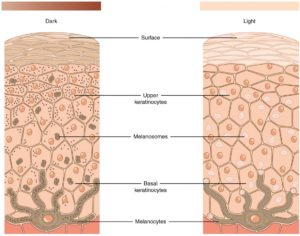the first APPEARANCE
overview: vitiligo in the world
Vitiligo is an autoimmune disorder that impacts over 1% of people across the world. Vitiligo can occur at any age and is not always genetic. While there is no dependable cure, many western treatments and doctors recommend light and laser therapy, as well as drugs that target the immune system.
Biological view

The left side of the diagram from LumenLearning illustrates the skin epidermis with sufficient melanocytes. On the other hand, the right side has no melanocytes, and therefore results in a lighter skin tone.
In vitiligo patients, the melanocytes, which are body cells that produce melanin, can no longer function. This lack of pigment-producing cells results in white skin. The most obvious symptom of vitiligo is white spots of skin; while it is more visually obvious on people who have darker skin, it also appears on light skin. Light therapy stimulates the body to secrete chemicals that increase melanin production. Many drugs are also used to suppress the over-active immune system to reduce the occurrence of cell-death in melanocytes.
psychological view
Many have argued that the mental hardships that vitiligo patients undergo is somewhat more taxing than the physical hardships. Vitiligo does not directly threaten someone’s physical health and is not fatal, but coping with the different skin tones can lead people to feel uncomfortable and unaccepted.
the kirkland treatment – protopic
My first white spots appeared around my lips and eyes when I was six years old. Due to my grandma’s brief experience with Vitiligo on her stomach, my parents were somewhat familiar with the condition and started taking note of the pigmentation’s location and where it was spreading. Unfortunately, spots started appearing everywhere, from my face to my legs, feet and hands. So, my mom reached out to a pediatric dermatologist in Kirkland. After waiting several weeks for an appointment, we met with Dr. Likosky, who had worked with few vitiligo cases prior. She recommended an ointment called Protopic, which is still in circulation among some doctors today. We applied the sticky cream to my spots every night for years. While I was very young and don’t remember every detail of this treatment, I can vividly recall how much I complained and absolutely hated putting on the cream every night. While it took five minutes max to apply the cream everywhere, it would stick to my pajama pants and I would even have to use it at sleepovers in front of my friends – talk about embarrassing…
Unfortunately, there was no material impact from the Protopic ointment. According to the recommendations from several of my doctors, Protopic is known as a somewhat effective treatment because while it does not always bring back brown pigmentation, it does create a stagnancy within the immune system so that new white skin does not form. While I didn’t know it at the time, this strategy of hindering the growth of vitiligo as opposed to directly trying to return brown pigmentation is a very common method of treatment. Unfortunately, however, this initial treatment did not stop new spots from growing on my appendages. Thus, my parents moved onto the next treatment, which will be discussed in my next blog.
I would also like to mention that there are currently several studies and trials for vitiligo. In a future blog, I hope to share some important trials in the vitiligo community on the journey to finding a cure. Thank you for reading:).